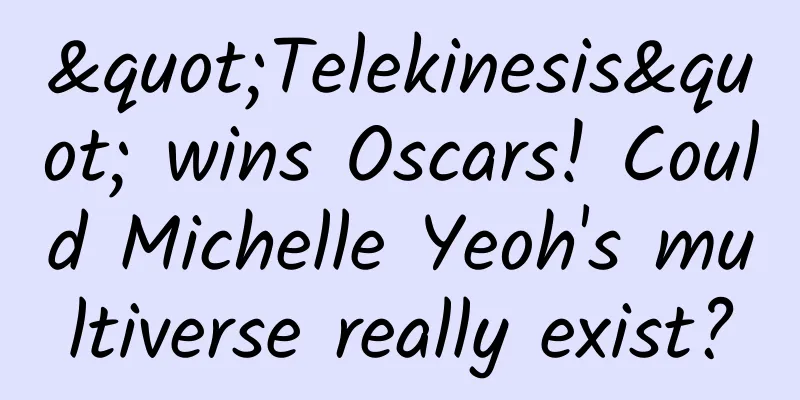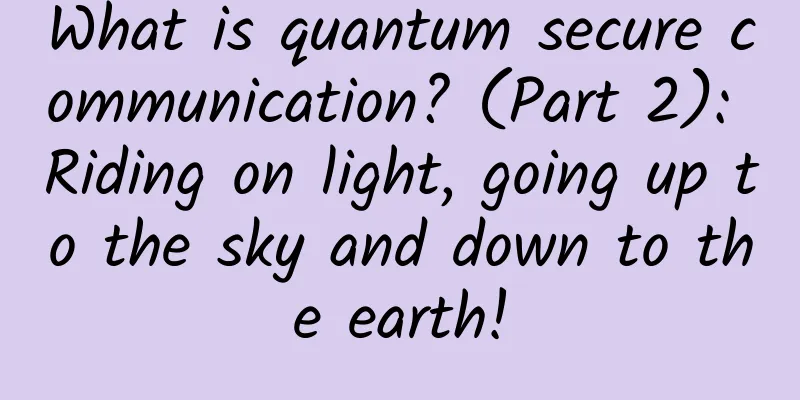"Telekinesis" wins Oscars! Could Michelle Yeoh's multiverse really exist?

|
The first Asian-American Oscar winner for Best Actress was born, and "The Universe" swept the Oscars. Although the Oscars' reviews are getting worse year by year, they seem to bring us something new every year. Today, the science fiction film "Blink" with an all-Asian cast won seven major awards at the Oscars, including Best Picture, Best Director, Best Actress (Michelle Yeoh), Best Supporting Actor (Kevin Kwan), Best Supporting Actress (Jamie Lee Curtis), Best Original Screenplay, and Best Editing. Michelle Yeoh became the first Chinese actress to win the Oscar for Best Actress and the first Asian to win the Oscar for Best Actress. △The New York Times reported the birth of the first Asian Best Oscar Actor in history "Television" tells a brain-opening and bizarre science fiction story. The reason why it won so many Oscars is inseparable from its ingenious core setting: the multiverse, which is a common concept in science fiction movies - the parallel universe . Although this setting has almost become a cliché, movies such as "Spider-Man 3" and "Doctor Strange 2" have applied the concept of parallel universes, but they have only borrowed the surface of the concept and have not gone deep into the essence. △The title of "Doctor Strange 2" is "Multiverse of Madness" "Almost nothing" plays with this concept in a different way: in the film, there are many universes parallel to our world, and the "me" in each universe may live a completely different life from another "me", but there is an "alpha universe" that is the starting point of everything. Countless cosmic versions of the heroine appear in the film one after another: a kung fu superstar, a chef, and even... a stone. It may sound a bit outrageous and a bit far-fetched, but in fact the "multiverse" is a real concept (hypothesis). There are many different interpretations of parallel universes, and different people have different understandings of what they are. "The Blink of an Eye" explores its most wonderful aspect: "choice" . If there is another world, would it be better? If I had other choices in life, would I live a more exciting life? △ Screenshot of "The Instant Universe" In this article, we will talk about the "multiverse" in reality that has fascinated countless directors and even scientists. (The following text is compiled and adapted from "40,000 Years of Human Universe". The content is a bit hardcore, so you can choose to read it at your discretion) 01 Do we really live in a multiverse? Cutting-edge cosmologists have made this claim: Imagine that our universe is extremely large - so large that there may be other regions that are so far away from us that we cannot find them by detection. In such a large space, the universe can replicate itself countless times. △The protagonist of the movie "Doctor Strange" has the ability to jump into different universes. Photo/MARVEL In this way, instead of requiring countless universes with slightly different natural constants, there would be only one infinitely large universe in which everything that could possibly happen happens. One hypothesis is that there is a copy of the known universe somewhere, which also contains a copy of ours. The histories of the two universes are exactly the same, and the only difference is the choices (for example, you in the other universe stop reading right now and put your phone on the table). In fact, in this multiple reality, the number of possible outcomes of each quantum measurement will cause the universe to split into as many parallel universes as possible. △Scientists describe multiple universes as bubbles. Photo/Wikipedia In other words, the universe is constantly branching out like a fractal, and taking an infinite number of different "paths", and "our universe" is just one of the paths, and it is impossible to connect with other paths. To quote Max Tegmark, a Swedish cosmologist who teaches at the Massachusetts Institute of Technology: "The size of the multiverse is immeasurable, so large that if we want to meet 'other selves', we need to travel a long way - the distance is more kilometers than the number of known particles in the universe." But this is the theory advocated by cutting-edge cosmologists, and we're just giving a brief introduction without delving into the complex mathematics. 02 The Multiverse of Mathematical Probability The mathematical probability path believes that the number of universes is infinite, or at least an exaggeratedly large number. For example, Leonard Susskind, a professor of theoretical physics at Stanford University, even assumed in his book The Cosmic Landscape that there are 10^500 universes, after specifically explaining quantum theory. Although not infinite, this number is astonishing enough. The physical properties of each universe are different, and these differences, no matter how small, are all due to the different values of the fundamental constants of nature. (For example, the basic charge e, the gravitational constant G, the Planck constant ħ, the speed of light in a vacuum c, and the vacuum dielectric constant ε0.) △Some researchers believe that on the other side of the Big Bang timeline, extending back, there once existed a universe that was exactly the same as our own. Photo/NASA For example, in our universe, the gravitational constant is equal to 0.0000000667 dynes. There must be another universe where the other constants are the same as in our universe, with only a slight difference in the value of the gravitational constant. Of course, the value of the gravitational constant in other universes may be another number, or the difference may not be in the gravitational constant but in another constant, or the combination of constants may be different. In short, for all possible values of all constants and their combinations, there is a corresponding universe. At this point, the reason we live in such a universe is clear: because this is the only universe in which we can live the way we do. This is also the view of British astronomer Denis Sharma, who believes that there are infinitely many universes, each with its own evolutionary history . Some people are unwilling to accept this view, and instead believe that there should be a reasonable explanation for the specific values of the fundamental constants, but we have not found it yet. Perhaps this is a sign of the emergence of "new physics" waiting for us to explore. Lee Smolin, an American physicist and mathematician at the University of Waterloo in Canada, proposed an exciting idea. He hypothesized that there is a cosmic matrix similar to a life entity, which is responsible for reproduction and selecting the optimal conditions to produce "children" - the newborn universe . According to Smolin, there may be a mechanism that selects the values of the constants of nature to maximize the number of black holes, since black holes are the very source of newborn universes. So in this fantastic scenario, the values of the fundamental constants (and therefore our existence) depend on the ability to form large numbers of black holes. In such a universe, we humans are just an accident. All of this makes us wonder: Is there really no way for us to verify the existence of a multiverse? 03 Is there really no way to verify the multiverse? Now, it's time to get down to earth and return to our own universe. We need to consider how to prove the multiverse theory and try to ask ourselves, is it really impossible to verify this theory through scientific means? Is it possible to find some evidence, or at least a hint, that would lead us to believe this is true? Don't forget that any scientific theory needs to be supported by factual observations, and with regard to the multiverse theory, so far we have only mentioned the mathematical and probabilistic reasons. Any theory, if it is to be a scientific theory, must build a model, use it to make predictions, and verify it through observation. But how do we observe another universe, or at least make us aware of the possibility of another universe ? △Our universe may be in a black hole. This is an interesting theory: the singularity - an infinitely small point with infinite density and temperature - is both the starting point of the universe and the center of a black hole. The observations that prove the Lambda cold dark matter universe model are reasonable may also indicate that another scenario is correct. The universe can be described as a hologram in a "bottle". Figure/40,000 Years of Human Universe Here, the paradigm of scientific models doesn't seem to work either, but there are still people working hard to find observational data. If there are really so many universes we are talking about, then it is not completely impossible to get in touch with them. Some even hypothesize that our universe was created by a collision with another universe. Although he does not support the multiverse theory, Paul Steinhardt, a theoretical physicist at Princeton University, imagines that before the Big Bang the universe consisted of two surfaces (brane) that were geometrically completely flat and developed along four dimensions. One of the "papers" is the predecessor of our universe, and the other represents the predecessor of a parallel universe. Random fluctuations in the parallel universe may have created distortions and interfered with the predecessor of our universe, causing the two to collide. The energy from this hypothetical collision could have caused our own Big Bang, transforming our predecessor universe into our current one. The other universe could have continued to exist on its own, or, who knows, perhaps it, too, had its own Big Bang. Because collecting evidence is so difficult, this debate is destined to continue for a long time, at least until the scientific frontier opens up a new path to solve the mystery of the multiverse. Perhaps we can start with dark matter. Understanding the composition of dark matter may help us better understand dark energy, and dark energy may help us better understand the mechanism of the expansion and acceleration of the universe (or multiverse). Maybe… Source: China National Geographic BOOK |
<<: Wearing masks is no longer mandatory! These places have made it clear →
Recommend
Activity plan operation process template
This template has a certain scope of application ...
NADA: Pulse Analysis of the U.S. Automotive Market in April 2022
The monthly "Market Beat" report releas...
Wandering "Love Rival Strategy Video Course" + "Love Rival Handbook"
Introduction to the resources of Langji's &qu...
When will Changchun express delivery resume in 2022? Which specific community has been unsealed? Attached the latest news
After more than a month of stumbling around the lo...
What does glass that can regulate sunlight look like?
Produced by: Science Popularization China Produce...
Average annual salary for US programmers hits new high
In the United States, the average annual salary o...
PS4 "Uncharted 4: A Thief's End": 1080P ultra-high-quality graphics make Drake's life a glorious end
May 10th is a day worthy of praise from many play...
A family member is suddenly diagnosed with cancer, what can we do for them?
It is inevitable that relatives, friends, and acq...
Practical application of Internet finance: Who touched your promotion fees?
If you are attracting new customers for an Intern...
Unable to avoid information manipulation, is the human brain outdated?
Why are humans so susceptible to believing obviou...
Why did the Samsung Galaxy Fold fail? Well-known disassembly agency iFixit gives their opinion
Samsung's Galaxy Fold foldable phone could no...
18 open source components used by NetEase News iOS version
[[134800]] Third-party open source libraries and ...
Product Operations: 4 Steps to Achieve Operational Growth!
I have collected several industry articles, and s...
Double awards! Jiyue won the Automotive Industry Summit Award again, highly recognized by international authoritative organizations
The recognition of a product by an international ...
Apple hasn’t lost its ability to innovate. It’s replicating the iPhone’s success in artificial intelligence.
The slowdown in smartphone sales is a well-known ...









